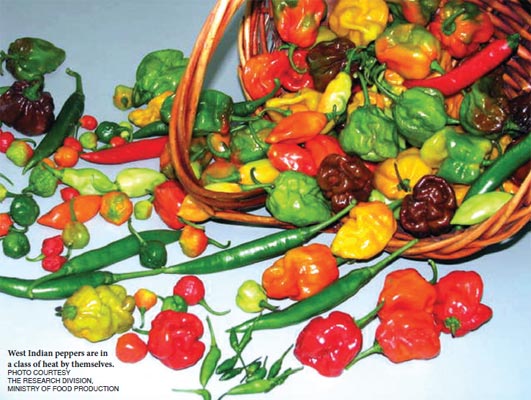|
September 2012

Issue Home >>
|

 Be it the thick, ripe clusters hanging invitingly from the shrub, the spectrum of colours in glistening market heaps, or a fine mince liberally sprinkled over a mango chow, to a true West Indian there seems to be no other that can put that special gleam in the eye or drool to the mouth like hot peppers. Be it the thick, ripe clusters hanging invitingly from the shrub, the spectrum of colours in glistening market heaps, or a fine mince liberally sprinkled over a mango chow, to a true West Indian there seems to be no other that can put that special gleam in the eye or drool to the mouth like hot peppers.
As reported in the June 2011 issue of UWI Today, the Trinidad Scorpion Butch T pepper surged into the international spotlight as the fiercest stinger, capturing the title of “hottest pepper in the world,” and setting a blistering record in chemical tests. A few months ago, Trinidad peppers were once again thrust into the world news, as the Trinidad Moruga Scorpion, dethroned the former and took its place as the Stinger Royale, setting a new Guinness World Record of 2,009,231 SHU on the pungency scale. The frenzy that it created worldwide can be gleaned by simply Googling the word ‘scorpion’. But can this siren heat that beckons both researcher and the general public at large, improve the livelihood of our peppers farmers today? We believe it can.
If you are one of the diehard enthusiasts who believes that no other pepper in the world smells, tastes and burns quite like what is found in the Caribbean then you would be absolutely correct. West Indian varieties such as Scotch Bonnet, Congo, Seven Pot, Scorpion, Pimento, Tiger Teeth, Bonda Majaque and Bazouka belong to a different class or species to the mainstream peppers like chili, sweet pepper, jalapeño, banana pepper, serrano and cayenne, commonly consumed around the globe.
Scientifically, local peppers are called Capsicum chinense, a misnomer from the days when the fruits were believed to have originated in China or when the West Indies were thought to actually be China (depending on which book you read).
Recent research at The UWI, featured on the cover of the July 2012 issue of the Journal of the American Society of Horticultural Science, has firmly established these peppers as native to the Caribbean and northern parts of South America, giving us every reason to be proud of this heritage.
This landmark article using molecular (DNA) fingerprinting techniques clearly establishes the existence of a distinct Caribbean cluster or gene pool, which is a reservoir of raw genetic potential that can be used to build novel varieties. The article traces the Caribbean pepper’s origin through historic contributions from the Upper Amazon gene pool, indigenous to the region encompassing Peru, Bolivia, Ecuador and Colombia and extending into the Guianas and Venezuela. Another distinct Lower Amazon gene pool from Brazil has also been identified for the first time. This may not sound particularly earth-shattering to the average reader but to the plant breeder this information is exactly what is needed for the efficient conservation of this genetic wealth and to devise strategies to create better pepper varieties.
Like building a jigsaw puzzle, the publication also pieces together the molecular fingerprinting data with archeological evidence gathered by UWI’s History Department, to trace the likely dispersal pathways for pepper from South America into Central America and the Caribbean. One such pathway takes pepper from its Amazon basin through the Guianas into Venezuela, Trinidad and Tobago and the Lesser Antilles by the early migrating Indians. Another pathway takes the pepper northwards through the Panamanian neck into Central America and the Greater Antilles.
Amidst all these exciting discoveries, researchers at the University are mainly occupied with the question of how these native varieties can be used to build a hot pepper industry that Trinidad and Tobago can be proud of; just as we are proud of our petrochemical industry that exploits our oil and gas reserves.
UWI researchers are committed to using the unearthed genetic resources to develop high-yielding, disease-resistant varieties capable of spawning a profitable hot pepper industry in the Caribbean and a global seed industry. What better way to paint the world red, white and black, than to build a future on the proud heritage of our natural resources!
The work on hot peppers is carried out by a team from the Department of Life Sciences of the Faculty of Science and Technology led by Prof. Pathmanathan Umaharan and including Dr. Winston Elibox and graduate students Marissa Moses, Sarah Bharath, Khalil Ali and Rabindra Ramjattan.
Marissa Moses is doing a PhD in Plant Science and is interested in investigating the diversity and population structure of Capsicum Chinense. She was the author of the article featured on the cover of the July 2012 issue of the Journal of the American Society of Horticultural Science (http://journal.ashspublications.org/content/137/4/250.full.html?ijkey=VhQgOhho6d8m1sn&keytype=ref) |





